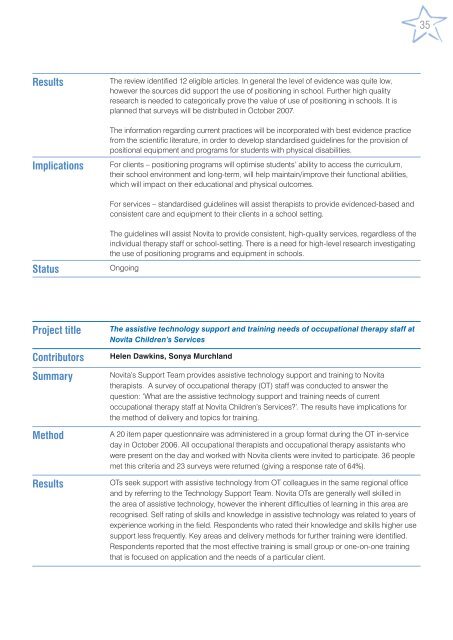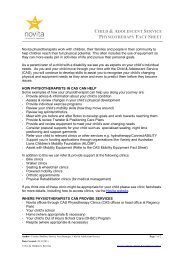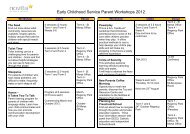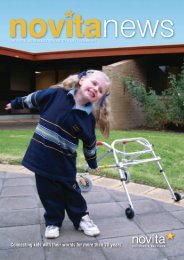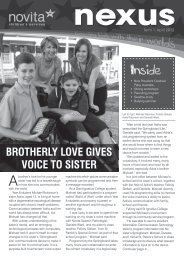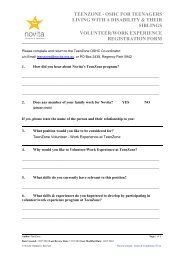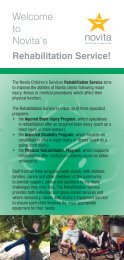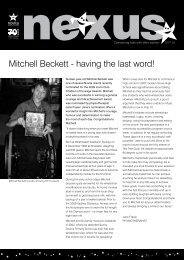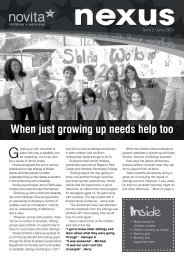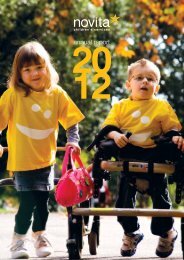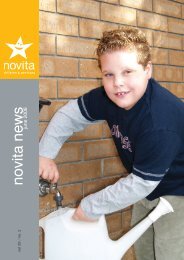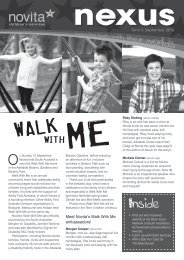Novita Research Report - 2004 to 2007 - Novita Children's Services
Novita Research Report - 2004 to 2007 - Novita Children's Services
Novita Research Report - 2004 to 2007 - Novita Children's Services
- No tags were found...
You also want an ePaper? Increase the reach of your titles
YUMPU automatically turns print PDFs into web optimized ePapers that Google loves.
35ResultsImplicationsThe review identified 12 eligible articles. In general the level of evidence was quite low,however the sources did support the use of positioning in school. Further high qualityresearch is needed <strong>to</strong> categorically prove the value of use of positioning in schools. It isplanned that surveys will be distributed in Oc<strong>to</strong>ber <strong>2007</strong>.The information regarding current practices will be incorporated with best evidence practicefrom the scientific literature, in order <strong>to</strong> develop standardised guidelines for the provision ofpositional equipment and programs for students with physical disabilities.For clients – positioning programs will optimise students’ ability <strong>to</strong> access the curriculum,their school environment and long-term, will help maintain/improve their functional abilities,which will impact on their educational and physical outcomes.For services – standardised guidelines will assist therapists <strong>to</strong> provide evidenced-based andconsistent care and equipment <strong>to</strong> their clients in a school setting.StatusThe guidelines will assist <strong>Novita</strong> <strong>to</strong> provide consistent, high-quality services, regardless of theindividual therapy staff or school-setting. There is a need for high-level research investigatingthe use of positioning programs and equipment in schools.OngoingProject titleContribu<strong>to</strong>rsSummaryMethodResultsThe assistive technology support and training needs of occupational therapy staff at<strong>Novita</strong> Children’s <strong>Services</strong>Helen Dawkins, Sonya Murchland<strong>Novita</strong>’s Support Team provides assistive technology support and training <strong>to</strong> <strong>Novita</strong>therapists. A survey of occupational therapy (OT) staff was conducted <strong>to</strong> answer thequestion: ‘What are the assistive technology support and training needs of curren<strong>to</strong>ccupational therapy staff at <strong>Novita</strong> Children’s <strong>Services</strong>?’. The results have implications forthe method of delivery and <strong>to</strong>pics for training.A 20 item paper questionnaire was administered in a group format during the OT in-serviceday in Oc<strong>to</strong>ber 2006. All occupational therapists and occupational therapy assistants whowere present on the day and worked with <strong>Novita</strong> clients were invited <strong>to</strong> participate. 36 peoplemet this criteria and 23 surveys were returned (giving a response rate of 64%).OTs seek support with assistive technology from OT colleagues in the same regional officeand by referring <strong>to</strong> the Technology Support Team. <strong>Novita</strong> OTs are generally well skilled inthe area of assistive technology, however the inherent difficulties of learning in this area arerecognised. Self rating of skills and knowledge in assistive technology was related <strong>to</strong> years ofexperience working in the field. Respondents who rated their knowledge and skills higher usesupport less frequently. Key areas and delivery methods for further training were identified.Respondents reported that the most effective training is small group or one-on-one trainingthat is focused on application and the needs of a particular client.


